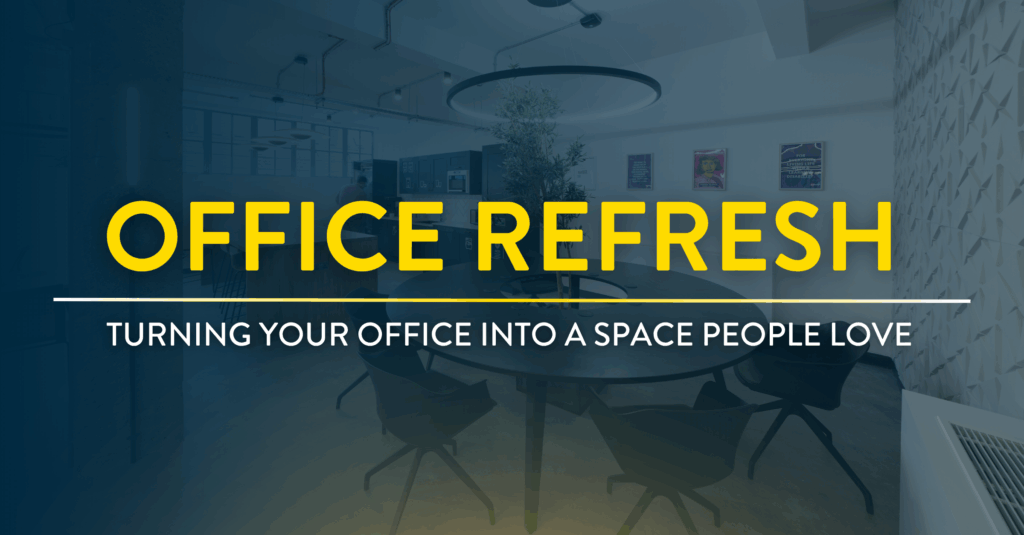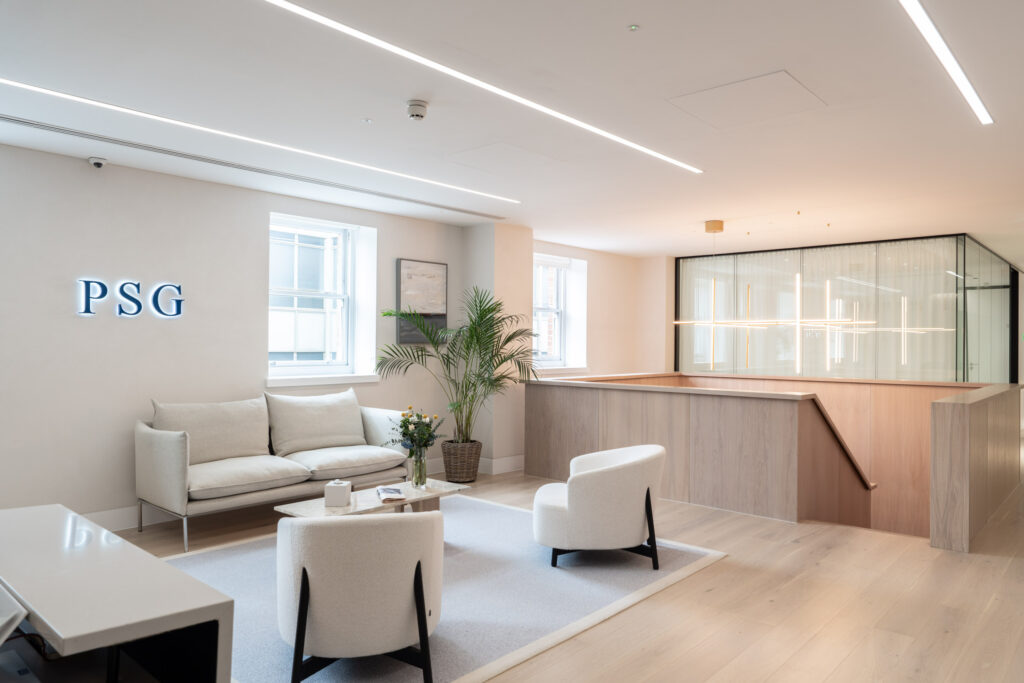
Across London and the wider UK, more organisations are choosing to stay put rather than move. Long lease commitments, a shortage of high-quality stock and the disruption of relocation have made refurbishment an increasingly compelling option. When it is done well, a refresh can transform performance without the need to change postcode.
Why an Office Refresh Matters
The case for doing something rather than nothing is strong. The Times reported that poorly designed workplaces cost the UK economy £71.4 billion each year in wasted time and inefficiency. Other research has found that a significant share of office workers describe their environment as outdated or uninspiring, and many believe they would be more productive if the office better supported how they work.
In that context, a refresh is not a coat of paint. It is an opportunity to modernise, reconfigure and realign the space around your teams so they can do their best work. The goal is to lift morale, support collaboration and improve retention while avoiding the cost and upheaval of a move.
Start With Evidence, Not Assumptions
Every successful refresh begins with understanding how people use the space today. That means going beyond headcount and desk counts. It means observing patterns, capturing pain points and learning what the business needs next year as well as what it needed last year.
At Constructive Space we typically start with design workshops and space utilisation studies. Workshops bring leadership and staff into the same conversation so we can understand strategy, culture and brand expectations. Utilisation studies show how desks, meeting rooms and informal areas are actually used across the week. Together they reveal which settings are oversubscribed, which sit empty, and where the environment is getting in the way of good work. The output is a clear brief that is grounded in evidence rather than guesswork.
From that brief we create scenarios. One scenario might focus on collaboration and knowledge sharing for a team that is growing quickly. Another might prioritise quiet space and acoustic privacy for teams that handle sensitive work. A third might target hybrid meeting quality for clients who need to host external partners. These scenarios show the trade-offs in black and white, and help clients choose with confidence.

Reimagining Layout and Flow
Small moves can unlock big gains. Rebalancing the ratio of collaboration space to focus space can reduce noise and distraction without reducing capacity. Removing unnecessary partitions brings natural light deeper into the plan and improves visibility between teams. Turning a seldom used store room into a flexible project room creates a setting that can flex from workshop to training to quiet refuge, all in the same footprint.
Flow matters as much as the settings themselves. If touchdown benches sit in thoroughfares they won’t be calm enough for concentrated work. If phone booths are buried at the far end of the floor, people will not use them for quick calls. If collaboration areas sit right on top of quiet teams, both groups will be frustrated.
It’s important to plan adjacency and movement so the right activities sit together, and to design buffers where they are needed. When the layout supports the rhythm of the day, people feel less fatigued and more in control.
Designing for Hybrid Realities
Hybrid work has not removed the need for the office. It has made the office more purposeful. People now arrive with specific reasons to be there. They come to collaborate, to learn from colleagues, to build relationships and to focus when home is not suitable.
A refresh should therefore make the most of those days in. High quality video enabled rooms of different sizes help meetings feel equitable for remote and in person participants. Writable surfaces at varied heights encourage movement and participation. Project tables with power in the centre support longer working sessions. Quiet carrels and library style benches give individual focus a respected home.
When the office offers a range of good choices, staff can choose the right setting for the task and the day.

Comfort and Wellbeing as Performance Drivers
Comfort is not a luxury. It is a performance variable.
Lighting, acoustics, temperature and air quality directly affect accuracy, alertness and fatigue. Improved ventilation and fresh air have been linked to measurable productivity gains, and well considered lighting can lift performance further.
In practice that means upgrading to efficient LED systems with the right colour temperature for the task, using glare control where daylight is strong, and planning layered lighting so spaces feel calm and legible. It means designing acoustic control into ceilings, walls and furniture rather than trying to fix noise after the fact. It means giving people some degree of personal control, for example task lights at desks or the ability to choose a quieter setting nearby.
Biophilic design is another proven route to healthier workplaces. Bringing natural materials, patterns and planting into the environment supports lower stress and better cognitive function. Daylight access remains the most powerful biophilic element of all, so layouts that pull light deep into the plan are especially valuable. These interventions do not require a dramatic budget. Even modest changes, consistently applied, can lift mood and reduce the background friction that otherwise accumulates through the day.
A Visual Refresh With Purpose
Look and feel matters because workplaces are symbols as well as tools. A well-considered palette can make an environment feel coherent and modern without starting from scratch.
Reupholstering high quality pieces or refinishing timber often makes more sense than buying new. Colour psychology can support different modes of work, with calmer tones in focus areas and more energetic tones in collaborative zones. Brand expression does not need to shout however, subtle cues in materials, artwork and wayfinding can make a space feel unmistakably yours while remaining timeless.
We also advise clients to think about the moments that shape memory. The first ten metres from the front door set the tone for the day. A well organised reception, a clear view to daylight and an obvious sense of where to go next all help visitors and staff settle quickly.
Coffee points and social areas, such as barista bars, are another high value target. When these are placed well and designed with care, they become magnets that encourage informal exchange across teams.

Sustainability That Works in Practice
Refurbishment is already a sustainable act because it avoids the embodied carbon and waste of relocation or new build. A refresh can go further by favouring low carbon materials, recycled content and UK suppliers. Reuse should come first, followed by refurbishment and then recycling. At Constructive Space we run a Gifted Furniture Programme that channels surplus items to charities and community organisations, so they stay in use and out of landfill. This is better for the planet and better for budgets.
Operational sustainability is just as important. Efficient lighting and controls, well-tuned HVAC, good metering and simple user guidance reduce energy use day after day. The World Green Building Council has long linked high quality indoor environments to improved wellbeing and productivity, connecting environmental goals to clear business outcomes. A refresh is the perfect moment to bring these strands together and lock in long term gains.
Change Management and Communication
People accept change more readily when they feel involved and informed. Early engagement helps staff understand the why, not only the what. Piloting new settings before full rollout allows teams to test and give feedback. Clear communication about how to use new rooms and tools prevents confusion on day one.
After handover we encourage clients to keep an eye on how the space is working and to make small adjustments where necessary. Offices are living systems after all, even the smallest tweaks help keep them performing well.

Delivering in an Occupied Office
Working around an active business requires planning and control. Because we directly employ our own tradesmen, we can phase works intelligently, coordinate tightly and maintain consistent quality from start to finish.
We sequence noisy or disruptive tasks out of hours, apply rigorous dust and protection measures, and maintain clean, safe routes at all times. Our site teams are used to working in live environments where professionalism and courtesy matter as much as technical skill.
Governance, Budget and Programme
A refresh is most successful when governance is clear. A single point of decision making, a realistic programme and a disciplined change process keep momentum high.
We help clients build a business case that weighs cost against measurable benefits such as capacity gains, reduced churn, energy savings and recruitment advantages. We establish a programme that respects lease events, fiscal year constraints and seasonal patterns in your business. We plan procurement so long lead items do not derail delivery, and we provide transparent cost reporting, so stakeholders stay aligned.
Measuring Success
If you want the office to support performance, you should measure performance. Before work begins we capture a baseline. That might include utilisation data, satisfaction scores, meeting room availability and energy consumption.
After the refresh we measure again. The comparison shows what has improved and where further tuning would help. Some clients tie these measures to wider HR and operational metrics such as staff retention, onboarding speed or client satisfaction. The more you connect the workplace to business goals, the stronger the return on investment.

Why Constructive Space
We have been delivering office design and fit out projects since 1977, with more than 1,000 projects completed for charities, legal practices, life sciences organisations and corporate head offices.
Our model is simple. We place design, delivery and aftercare under one roof, we directly employ our own tradesmen and we stay accountable for the outcome. This allows us to phase works in occupied buildings, maintain consistent standards, and respond quickly when priorities shift. Most importantly, it allows us to focus on what matters to you, which is a space that helps your people and your organisation thrive.
Unlock the Potential of Your Current Space
If your office feels tired, it does not mean you have outgrown it. With the right insight and a disciplined approach, you can reconfigure what you have, upgrade what matters and express your brand with confidence.
You can improve wellbeing, support collaboration and give people a workplace they choose to use. A refresh turns a cost centre into a performance tool. It turns a place people tolerate into a place people love.


